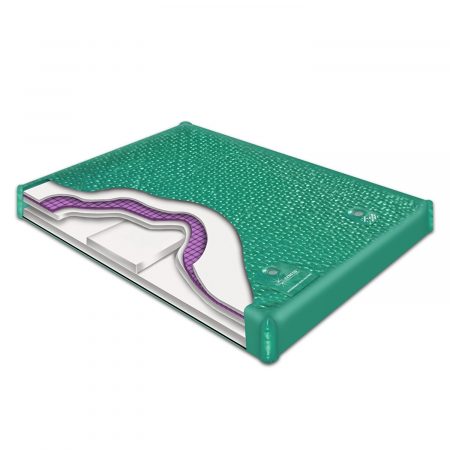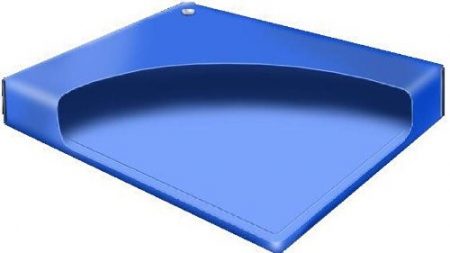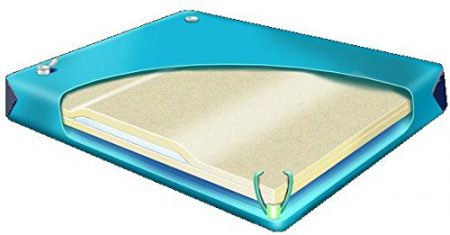Waterbed Lifespan and Warranty Considerations
If properly maintained, waterbeds can perform for seven years or longer. This gives them comparable lifespans to more durable mattress types, such as latex, hybrid, and airbed models. However, waterbeds are uniquely vulnerable to certain issues – such as water leaks and heater malfunctions – that can shorten their lifespan by a considerable margin.
Hardside waterbeds are considered the least durable because there is less padding and material to protect the water chamber. Any sharp object can cause a puncture; pet claws are especially problematic, meaning cats and dogs should never be allowed onto a hardside waterbed. Softside models are more durable overall. However, leaks can be harder to address if they develop due to their thick frames.
Because they are heavy and difficult to ship and assemble, most waterbed manufacturers do not offer a sleep trial of any kind. Instead, most brands offer longer-than-average warranties – typically 15 to 20 years minimum. Common defects covered under a waterbed warranty include splits or tears at the seams that cause leaks, and issues with waterbed zippers. Softside waterbeds with foam comfort layers may also warrant against excessive sagging or indentations, much like the warranties for standard mattresses.
Because waterbed warranties are longer, shoppers should pay close attention to the nonprorated vs. prorated schedule. During the nonprorated period, waterbed owners pay nothing for repairs or replacements if a defect develops except for shipping and handling charges. However, once the prorated phase kicks in owners must pay a certain percentage of the original product price. This percentage often increases with each year of ownership.
For instance, let’s say a $1,000 waterbed is covered under a 20-year warranty with 10 years of nonprorated coverage. In year 11, when prorated coverage kicks in, the owner must pay 5% of the original price for each year of ownership to replace the mattress; because it’s year 11, this percentage is 55%, or $550. In year 12, it will increase to 60%, or $600. As a result, prorated warranties can lead to extra owner costs down the road.
Another factor to consider is separate warranties for specific components. Commonly, the waterbed cover will be covered separately – for only one to two years, in some cases. Heaters may also be covered under separate warranties. If a defect does not develop with these components during their individual warranty period, then the overall waterbed warranty will not cover the issues.
Important Questions for Waterbed Shoppers
- How much do you want to spend on a waterbed? Hardside waterbeds are generally much cheaper than softside models. By the same token, free-flow waterbeds tend to be less expensive than semi-waveless and waveless models.
- Do you enjoy wave sensations? If yes, then a free-flow waterbed should be your ideal choice. These beds offer semi-intense to intense waves and close contact with the water. If no, then a waveless waterbed will be suitable. Those who like some waves may want to opt for a semi-waveless waterbed.
- What bed size do you prefer? Both hardside and softside waterbeds are available in limited sizes compared to other mattress types, though softside sizes offer more options. Keep in mind that hardside waterbeds usually require new sheet sets, whereas softside models do not.
- Do you experience back pain? Waterbeds with lumbar support are much better for sleepers with back pain. Those that do not have supportive components may exacerbate discomfort.
- Do you sleep with a partner? If you share your bed with someone and you tend to wake up due to motion transfer, then a semi-waveless or waveless waterbed will probably be the best option. Free-flow waterbeds do not isolate very much motion, leading to frequent sleep disruptions.
- What are your bedroom dimensions? Hardside waterbeds take up much more room than softside beds; regardless of which type you’d like to purchase, be sure to measure your room to ensure the bed will fit.
- What’s your ideal sleep temperature? If you like a little warmth while you sleep, a hardside bed with a high-watt heater will be the best option; these beds heat the water quickly and effectively, though they use a fair amount of power. If you prefer to sleep cool, then a softside waterbed with a slower low-watt heater may be sufficient. If you like to sleep exceptionally cold, then you may not need the heater at all.
- Are you sensitive to smell? Waterbeds tend to produce more off-gassing odor than other mattresses. This is especially true for hardside waterbeds with vinyl covers. Waterbed smells may be excessively strong and persist for longer periods of time.
- Do you have an outside faucets? If no, you may want to reconsider getting a waterbed. Draining a water chamber is much easier with outside faucets and lowers the risk of damaging indoor spills.


